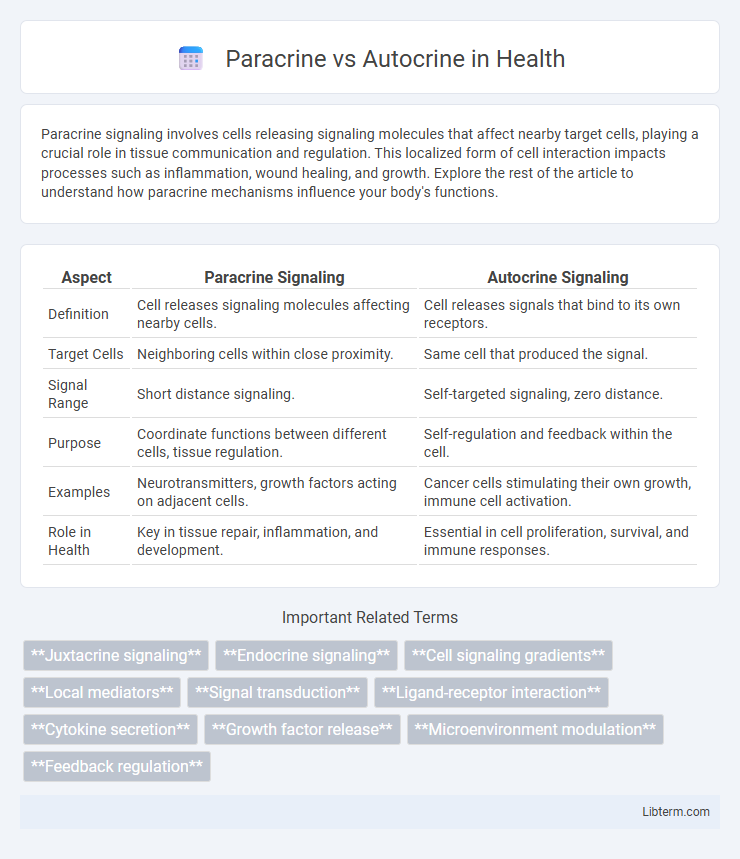Paracrine signaling involves cells releasing signaling molecules that affect nearby target cells, playing a crucial role in tissue communication and regulation. This localized form of cell interaction impacts processes such as inflammation, wound healing, and growth. Explore the rest of the article to understand how paracrine mechanisms influence your body's functions.
Table of Comparison
| Aspect | Paracrine Signaling | Autocrine Signaling |
|---|---|---|
| Definition | Cell releases signaling molecules affecting nearby cells. | Cell releases signals that bind to its own receptors. |
| Target Cells | Neighboring cells within close proximity. | Same cell that produced the signal. |
| Signal Range | Short distance signaling. | Self-targeted signaling, zero distance. |
| Purpose | Coordinate functions between different cells, tissue regulation. | Self-regulation and feedback within the cell. |
| Examples | Neurotransmitters, growth factors acting on adjacent cells. | Cancer cells stimulating their own growth, immune cell activation. |
| Role in Health | Key in tissue repair, inflammation, and development. | Essential in cell proliferation, survival, and immune responses. |
Introduction to Cell Signaling
Paracrine signaling involves cells releasing signaling molecules that affect nearby target cells within the local environment, facilitating communication essential for tissue function and development. Autocrine signaling occurs when cells respond to signaling molecules they themselves secrete, playing a critical role in self-regulation and cellular feedback mechanisms. Both signaling types are fundamental components of cell communication, regulating processes like growth, differentiation, and immune responses.
Defining Paracrine Signaling
Paracrine signaling is a form of cell communication where signaling molecules are secreted by a cell and act on nearby target cells within the same tissue, facilitating localized cellular responses. Unlike autocrine signaling, where cells respond to their own secreted signals, paracrine signals influence neighboring cells, playing a critical role in processes like tissue repair, immune response, and development. Key molecules involved in paracrine signaling include growth factors, cytokines, and neurotransmitters that affect cells in the immediate microenvironment.
Understanding Autocrine Signaling
Autocrine signaling involves cells releasing signaling molecules that bind to receptors on their own surface, enabling self-regulation of cellular functions such as growth and immune responses. This mode of communication plays a critical role in processes like cancer progression and inflammatory responses by promoting cell proliferation and survival. Understanding autocrine signaling mechanisms enhances insights into targeted therapies aimed at disrupting abnormal cell signaling pathways.
Key Differences Between Paracrine and Autocrine
Paracrine signaling involves cells releasing signaling molecules that affect nearby target cells within the local environment, whereas autocrine signaling occurs when cells release signals that bind to receptors on their own surface, influencing their own activity. Key differences include the range of action, with paracrine signals affecting neighboring cells and autocrine signals acting on the originating cell itself. Paracrine communication plays a crucial role in tissue-specific responses, while autocrine signaling is essential for self-regulation and feedback mechanisms within a cell.
Biological Functions of Paracrine Mechanisms
Paracrine signaling involves the release of signaling molecules that affect nearby target cells, playing a critical role in tissue development, immune responses, and wound healing. This mechanism enables precise spatial regulation by facilitating cell-to-cell communication within the local microenvironment through factors like growth factors, cytokines, and neurotransmitters. Paracrine interactions modulate cellular behavior, proliferation, differentiation, and apoptosis, thereby maintaining homeostasis and coordinating complex biological processes.
Physiological Roles of Autocrine Pathways
Autocrine pathways play a critical role in regulating cell growth, differentiation, and immune responses by enabling cells to respond to signals they themselves secrete, such as cytokines and growth factors. This self-stimulation mechanism is essential for maintaining homeostasis and facilitating tissue repair processes. In cancer biology, autocrine signaling often contributes to tumor progression by promoting uncontrolled proliferation and resistance to apoptosis.
Examples of Paracrine Signaling in the Body
Paracrine signaling involves the release of signaling molecules that affect nearby target cells, exemplified by factors such as fibroblast growth factors (FGFs) promoting tissue repair and epidermal growth factor (EGF) stimulating cell growth in wound healing. Another key example includes nitric oxide (NO) produced by endothelial cells inducing vasodilation in adjacent smooth muscle cells, crucial for blood pressure regulation. Histamine released by mast cells during immune responses acts on neighboring cells to increase vascular permeability, facilitating inflammation and pathogen defense.
Examples of Autocrine Signaling in Health and Disease
Autocrine signaling is critical in immune responses where T cells release interleukin-2 (IL-2) to promote their own proliferation and activation, enhancing the body's defense mechanisms. In cancer, tumor cells often exploit autocrine signaling by producing growth factors such as epidermal growth factor (EGF), driving unchecked cell growth and tumor progression. This self-stimulating communication pathway also plays a role in tissue repair, as fibroblasts secrete transforming growth factor-beta (TGF-b) to regulate their own activity during wound healing.
Clinical Implications: Paracrine vs Autocrine
Paracrine signaling plays a critical role in wound healing and tissue regeneration by enabling cells to communicate locally and coordinate repair processes, while autocrine signaling is often implicated in cancer progression due to its ability to promote uncontrolled cell growth through self-stimulation. Therapeutic strategies targeting paracrine pathways, such as growth factor blockers, show promise in diseases characterized by excessive inflammation, whereas autocrine signaling inhibitors are being explored to disrupt tumor cell survival and resistance mechanisms. Understanding the distinct roles of paracrine and autocrine communication is essential for developing precise interventions in cancer treatment and inflammatory disorders.
Future Directions in Cell Communication Research
Future research in cell communication is exploring the molecular mechanisms distinguishing paracrine and autocrine signaling pathways, aiming to develop targeted therapies for cancer and immune disorders. Advances in single-cell RNA sequencing and live-cell imaging are expected to reveal dynamic interactions and temporal patterns in cell signaling. The integration of computational modeling with experimental data will enhance the precision of predicting paracrine and autocrine signaling effects in complex tissue environments.
Paracrine Infographic

 libterm.com
libterm.com